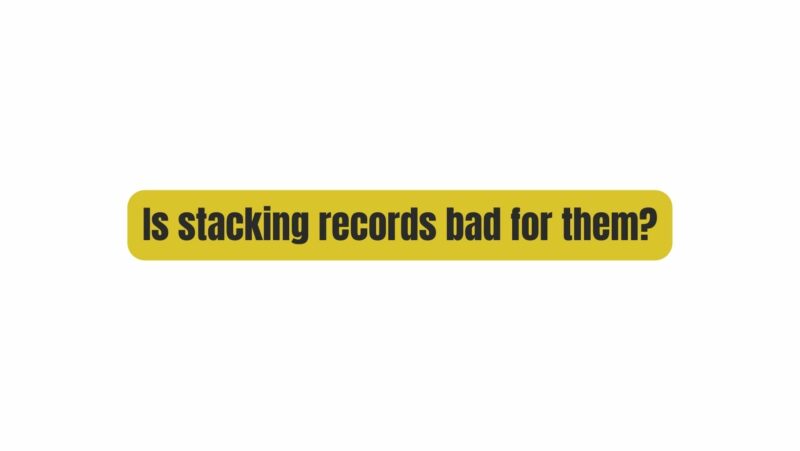Vinyl records are revered for their rich, analog sound and tactile charm, making them a beloved medium for audiophiles and collectors alike. As the resurgence of vinyl continues to grow, enthusiasts often find themselves with expanding collections, raising questions about the best practices for storing and handling records. One common concern is whether stacking records is detrimental to their condition. In this comprehensive article, we will explore the intricacies of stacking vinyl records, dissect the potential risks, and offer guidance on preserving your cherished collection.
I. Understanding the Anatomy of Vinyl Records
To assess the impact of stacking on records, it’s essential to first grasp the fundamental components that constitute a vinyl record:
- Vinyl Disc: The vinyl disc itself serves as the medium for audio playback, typically available in various sizes, with the 12-inch LP (long-playing) and 7-inch single being the most common.
- Grooves: The audio content is stored in grooves that are intricately etched onto the vinyl surface. These grooves spiral from the record’s outer edge toward the center, containing the music’s physical representation.
- Label: Located at the center of the record, the label displays essential information such as the album title, tracklist, and artist details.
- Dead Wax: The area situated between the final track’s groove and the label is known as the “dead wax” and typically contains no audio information.
II. The Vulnerability of Vinyl Records
Vinyl records, while celebrated for their sonic qualities, are renowned for their fragility. Several factors contribute to their vulnerability:
- Material Composition: Vinyl records are crafted from a relatively brittle material that can shatter or crack upon impact.
- Thinness: Records are relatively thin, which makes them less structurally robust compared to other materials.
- Groove Depth: Grooves on vinyl records are shallow and intricately etched, rendering them sensitive to damage that can affect playback.
- Weight Distribution: Records are circular and have an empty center, making them susceptible to warping and breakage when subjected to uneven force.
Given these vulnerabilities, it’s understandable why collectors and enthusiasts may be concerned about stacking records.
III. The Consequences of Stacking Records
Stacking records, particularly if done carelessly or with insufficient support, can lead to a range of negative consequences:
- Surface Scratches: Stacking records on top of each other without proper protection can result in surface scratches or scuffs, which create audible pops and crackles during playback.
- Groove Damage: Stacking records can cause deep grooves to press against each other, leading to groove damage that can result in skips, distortions, or unplayable tracks.
- Warping: The weight of records stacked upon one another can cause warping, where the record is no longer flat and does not sit evenly on the turntable. Warped records can be challenging to play correctly and may cause tracking issues.
- Ring Wear: Records stacked on top of each other can create “ring wear” or “ring marks” on the record sleeves, which can affect their aesthetic appeal and collectible value.
- Accumulation of Static Electricity: When records are stacked tightly together, they can accumulate static electricity, attracting dust and debris that can affect playback quality.
- Increased Risk of Breakage: Excessive stacking can exert uneven pressure on records, increasing the risk of breakage or cracks.
- Reduced Resale Value: For collectors, any damage to a vinyl record, including that caused by improper stacking, can significantly diminish its resale value.
IV. Best Practices for Storing and Displaying Vinyl Records
To preserve your vinyl records and their condition, it’s essential to adopt proper storage and display practices:
- Store Vertically: Keep records stored vertically, similar to how books are kept on a shelf. Utilize record storage crates or dedicated shelving designed for vinyl records.
- Use Inner and Outer Sleeves: Invest in anti-static inner sleeves and outer jackets to protect your records from dust, scratches, and static electricity.
- Record Dividers: Utilize record dividers or inserts to keep records separated, preventing direct contact between them.
- Climate Control: Store records in a controlled environment with stable temperature and humidity levels to minimize the risk of warping or degradation.
- Avoid Overcrowding: Avoid overcrowding your storage space, as this can lead to records being tightly packed together, increasing the risk of damage.
- Proper Support: When stacking records vertically, ensure they have proper support to prevent leaning or warping.
V. The Vinyl Revival and Preservation
In recent years, there has been a resurgence of interest in vinyl records, driven by a renewed appreciation for analog audio quality and the tangible music experience they offer. The vinyl revival is characterized by several factors:
- Audiophile Appeal: Audiophiles appreciate the warm, analog sound quality that vinyl records provide, setting them apart from digital formats.
- Tangibility: Vinyl records offer a tactile and multisensory listening experience, from handling the record to cuing the stylus.
- Collectible Nature: Vinyl records, especially rare and limited editions, have gained value as collectibles, creating a thriving market.
- Nostalgia: Vinyl records evoke nostalgia for older generations and captivate younger generations intrigued by the format.
- Album Artwork: Larger album artwork and the physical presence of vinyl records contribute to their aesthetic appeal and visual impact.
As vinyl continues to thrive, the preservation of vinyl records becomes increasingly important for collectors and enthusiasts.
VI. Conclusion
In examining whether stacking records is damaging to them, we have considered the structural vulnerabilities of vinyl records, the potential consequences of improper stacking, and the best practices for caring for your vinyl collection. Vinyl records offer more than just a medium for music; they are tangible artifacts that connect us to the past and engage our senses uniquely.
So, the next time you consider storing or displaying your vinyl records, remember the delicate balance between vulnerability and preservation—a balance that underscores the enduring magic of vinyl and the commitment to safeguarding its legacy for generations to come.


